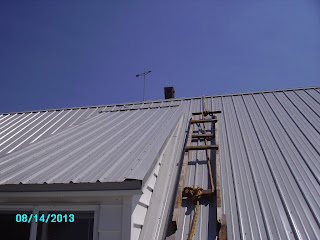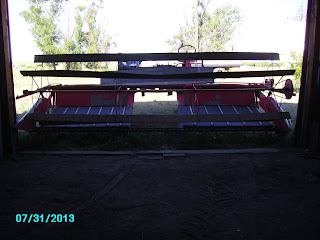August’s cool
start gave way to more typical weather, though nothing like last summer’s
record setters. It is still pretty dry,
but you wouldn’t know it from my attempt to farm.
The biggest rain
we have had has been .67” while south and east they have had multi-inch
rains. Still, I had problems getting the machine to
work properly due to the wetness of the soil, combined with the residue from
the grass that hasn’t decayed yet.
When I first
started, I had to stop about every 20-30 minutes to clean the grass and “mud”
(not quite that wet) off the bar. I
finished Monday afternoon with one or two cleansings all afternoon. Too early to plant wheat, so no use worrying
if I have enough moisture.
(When I was a
high school kid working for a neighbor farmer, we always started planting wheat
on August 21, unless that date fell on Sunday.
You would attract a lot of attention if you planted wheat that early
these days.)
On Tuesday I
indulged the Goodwife’s hobby of inspecting every house that has ever been
built. We went to Colorado Springs’
Parade of Homes. There were 35 homes on
the tour, from Peyton to the hills above the city. We toured our first house at ten o’clock,
when they opened up. We finally took a
break at an Outback Steakhouse about 4:30.
We left there about 5:30, too late to view any more. (Thank Goodness.)
Many of the
houses we toured were rebuilds where the fire destroyed them last year. Those all had a nice view of the flat old
plain stretching out to the east with the city center tucked up against the
hills. The cheapest one probably went for
$4k (most were privately owned and not for sale—mostly advertisements for
various builders) and went up to a million.
None of them had a floor plan I would use, even if I could afford to.
Thursday we
headed for Kansas. They have had more
moisture. The grass I had trimmed up three
weeks ago was up pretty high again.
Problem: Tecumseh engine on Marty
J riding mower had an exhaust valve that wouldn’t close. Four hours of troubleshooting and trying
different solutions on Friday produced no results.
It gave me an
excuse to phone my old buddy Ralph, sitting in a nursing home in San Diego. Ralph suggested liberal doses of WD-40. Or, flood the engine cylinder with automatic
transmission fluid. The WD-40 helped. I didn't have to go to plan B.
The ultimate
solution was a farmer one—use of bailing wire.
I threaded wire through the valve spring and made a loop around the
valve stem. I looped the other end of
the wire around a piece of copper pipe.
Using the pipe as a lever, and with an assist from a nail bar hooked
into the valve spring, I managed to persuade the valve to close all the way.
If I had to take
the engine apart, I would have to get the engine out of the mower. That would be a job.
About 12:30 p.m.
Saturday, the old engine came to life. I
spent four hours mowing in the upper ninety degree heat. I was quite happy. The alternative was my old Comet lawn mower. Or the slovenly solution of
just letting Nature take its course. (My German barbershop buddy who visits occasionally would look askance at that solution.)
Back to Colorado, where we enjoyed a round of golf in the cool evening.






























